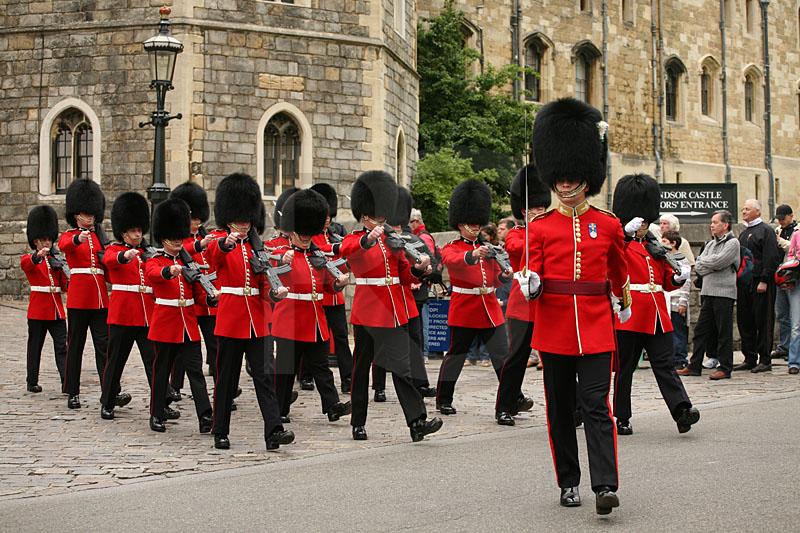There are many interesting features of living in a castle – and one of them is the guard change!



Changing the Guard or Guard Mounting is the process involving a new guard exchanging duty with the old guard.
The Guard which mounts at Buckingham Palace is called The Queen’s Guard and is divided into two Detachments: the Buckingham Palace Detachment (which is responsible for guarding Buckingham Palace), and the St. James’s Palace Detachment, (which guards St. James’s Palace). These guard duties are normally provided by a battalion of the Household Division and occasionally by other infantry battalions or other units.
When Guardsmen are on duty, the soldiers are drawn from one of the five regiments of Foot Guards in the British Army: the Scots Guards, the Irish Guards, the Welsh Guards, the Grenadier Guards and the Coldstream Guards.
The five Regiments may be recognised as follows:
|
Regiment |
Grouping of buttons |
Collar badge |
Plume on bearskin cap |
|
Grenadier Guards |
Singly |
Grenade |
White, worn on left side |
|
Coldstream Guards |
Twos |
Garter Star |
Red, worn on right side |
|
Scots Guards |
Threes |
Thistle |
No plume |
|
Irish Guards |
Fours |
Shamrock |
Blue, worn on right side |
|
Welsh Guards |
Fives |
Leek |
Green and white, worn on left side |
The Queen’s Guard is commanded by a Captain (who usually holds the rank of Major), and each Detachment is commanded by a Lieutenant. The Colour of the Battalion providing the Guard is carried by a Second Lieutenant (who is known as the Ensign).
The handover is accompanied by a Guards band. The music played ranges from traditional military marches to songs from films and musicals and even familiar pop songs.
When The Queen is in residence, there are four sentries at the front of the building. When she is away there are two.
The Queen’s Guard usually consists of Foot Guards in their full-dress uniform of red tunics and bearskins. If they have operational commitments, other infantry units take part instead.
Units from Commonwealth realms occasionally take turn in Guard Mounting. In May 1998, Canadian soldiers from Princess Patricia’s Canadian Light Infantry mounted guard at Buckingham Palace for the first time since the Coronation in 1953.
Household Troops have guarded the Sovereign and the Royal Palaces since 1660. Until 1689, the Sovereign lived mainly at the Palace of Whitehall and was guarded there by Household Cavalry.
In 1689, the court moved to St James’s Palace, which was guarded by the Foot Guards. When Queen Victoria moved into Buckingham Palace in 1837, the Queen’s Guard remained at St James’s Palace, with a detachment guarding Buckingham Palace, as it still does today.
At Windsor Castle, the ceremony takes place at 11.00 am. For most of the year Guard Mounting takes place on alternate dates, but it is held daily (except Sundays) from April to July.
There is no Guard Mounting in very wet weather.
